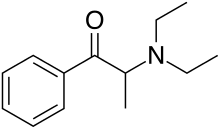Amfepramone
Amfepramone, also known as diethylpropion, is a stimulant drug of the phenethylamine, amphetamine, and cathinone classes that is used as an appetite suppressant.[2][3] It is used in the short-term management of obesity, along with dietary and lifestyle changes.[2] Amfepramone is most closely chemically related to the antidepressant and smoking cessation aid bupropion (previously called amfebutamone), which has also been developed as a weight-loss medicine when in a combination product with naltrexone.[4]
 | |
| Clinical data | |
|---|---|
| Trade names | Tenuate |
| Other names | Diethylpropion |
| AHFS/Drugs.com | Monograph |
| MedlinePlus | a682037 |
| Pregnancy category |
|
| Routes of administration | Oral |
| ATC code | |
| Legal status | |
| Legal status |
|
| Pharmacokinetic data | |
| Elimination half-life | 4-6 hours (metabolites)[1] |
| Excretion | Urine (>75%)[1] |
| Identifiers | |
IUPAC name
| |
| CAS Number | |
| PubChem CID | |
| IUPHAR/BPS | |
| DrugBank | |
| ChemSpider | |
| UNII | |
| KEGG | |
| ChEBI | |
| ChEMBL | |
| CompTox Dashboard (EPA) | |
| ECHA InfoCard | 100.001.836 |
| Chemical and physical data | |
| Formula | C13H19NO |
| Molar mass | 205.30 g/mol g·mol−1 |
| 3D model (JSmol) | |
| Chirality | Racemic mixture |
SMILES
| |
InChI
| |
| | |
Abuse
Amfepramone is believed to have relatively low abuse potential.[5][6][7][8] but recently there have been reports of teens and adults in the UK abusing this drug, known as "tombstones" to the abusers.
Pharmacology
Amfepramone itself lacks any affinity for the monoamine transporters and instead functions as a prodrug to ethcathinone.[9] Ethcathinone (and therefore amfepramone as well) is a very weak dopaminergic and serotonergic, and is approximately 10x and 20x stronger on norepinephrine in comparison, respectively.[9] As a result, ethcathinone and amfepramone can essentially be considered a member of the class of drugs known as norepinephrine releasing agents (NRAs).
Chemistry
Amfepramone can be synthesized from propiophenone by bromination, followed by reaction with diethylamine.[10][11]
Society and culture
Names
Another medically-utilized name is diethylpropion (BAN and AAN). Chemical names include: α-methyl-β-keto-N,N-diethylphenethylamine, N,N-diethyl-β-ketoamphetamine and N,N-diethylcathinone. Brand names include: Anorex, Linea, Nobesine, Prefamone, Regenon, Tepanil and Tenuate.
Legality
Amfepramone is classified as a Schedule IV controlled substance in the United States. It is also a Schedule IV controlled substance in Canada. In the UK Amfepramone is a class C drug [12] and as a medicine, it is a Schedule 3 Controlled Drug which requires safe custody.
See also
References
- "SPC-DOC_PL 16133-0001" (PDF). Medicines Healthcare products Regulatory Agency. Essential Nutrition Ltd. 18 November 2011. Retrieved 18 July 2014.
- Brayfield, A, ed. (30 January 2013). "Diethylpropion Hydrochloride". Martindale: The Complete Drug Reference. London, UK: Pharmaceutical Press. Retrieved 18 July 2014.
- "TGA Approved Terminology for Medicines, Section 1 – Chemical Substances" (PDF). Therapeutic Goods Administration, Department of Health and Ageing, Australian Government. July 1999: 42. Cite journal requires
|journal=(help) - Arias, HR; Santamaría, A; Ali, SF (2009). "Pharmacological and neurotoxicological actions mediated by bupropion and diethylpropion". International Review of Neurobiology. 88: 223–55. doi:10.1016/S0074-7742(09)88009-4. ISBN 9780123745040. PMID 19897080. Cite journal requires
|journal=(help) - Cohen, S (1977). "Diethylpropion (Tenuate): An Infrequently Abused Anorectic". Psychosomatics. 18 (1): 28–33. doi:10.1016/S0033-3182(77)71101-6. PMID 850721.
- Jasinski, DR; Krishnan, S (June 2009). "Abuse Liability and Safety of Oral Lisdexamfetamine Dimesylate in Individuals with a History of Stimulant Abuse". Journal of Psychopharmacology. 23 (4): 419–427. doi:10.1177/0269881109103113. PMID 19329547.
- "Tepanil (diethylpropion hydrochloride) tablet, extended release". Dailymed. National Institutes of Health.
- Caplan, J (May 1963). "Habituation to Diethylpropion (Tenuate)". Canadian Medical Association Journal. 88: 943–944. PMC 1921278. PMID 14018413.
- Rothman, RB; Baumann, MH (2006). "Therapeutic Potential of Monoamine Transporter Substrates". Current Topics in Medicinal Chemistry. 6 (17): 1845–1859. doi:10.2174/156802606778249766. PMID 17017961. Archived from the original on 2017-03-26. Retrieved 2019-04-17.
- US patent 3001910, "Anorexigenic Propiophenones", issued 1961-09-26, assigned to Temmler-Werke
- Hyde, J. F.; Browning, E.; Adams, R. (1928). "Synthetic Homologs of d,l-Ephedrine". Journal of the American Chemical Society. 50 (8): 2287–2292. doi:10.1021/ja01395a032.
- "Class C Drugs". Schedule 2 Controlled Drugs. UK Legislation.